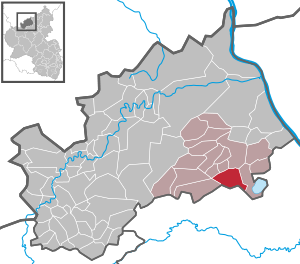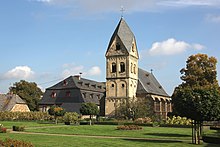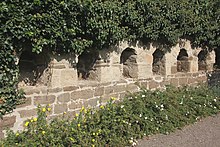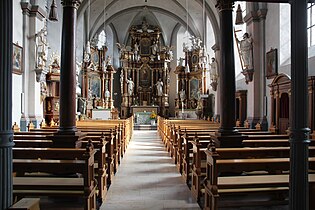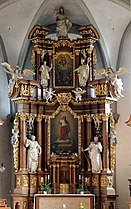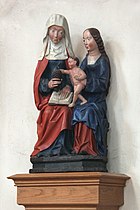Weir (eifel)
| coat of arms | Germany map | |
|---|---|---|

|
Coordinates: 50 ° 25 ' N , 7 ° 13' E |
|
| Basic data | ||
| State : | Rhineland-Palatinate | |
| County : | Ahrweiler | |
| Association municipality : | Brohl valley | |
| Height : | 308 m above sea level NHN | |
| Area : | 9.93 km 2 | |
| Residents: | 1117 (Dec. 31, 2019) | |
| Population density : | 112 inhabitants per km 2 | |
| Postal code : | 56653 | |
| Area code : | 02636 | |
| License plate : | AW | |
| Community key : | 07 1 31 210 | |
| Association administration address: | Kapellenstrasse 12 56651 Niederzissen |
|
| Website : | ||
| Mayoress : | Melanie Hilger | |
| Location of the local community Wehr in the Ahrweiler district | ||
Wehr is a municipality in the Ahrweiler district in Rhineland-Palatinate . It belongs to the Brohltal community , which has its administrative headquarters in Niederzissen .
geography
The community is located in the East Eifel west of the Laacher See . The Steinbergerhof and Welschwiesenmühle residential areas also belong to Wehr .
history
Remains of a Roman settlement were found in the Wehrer valley basin, but they can no longer be reconstructed due to agricultural use. The first documentary mention comes from the year 920. The village Wehr belonged to this later Premonstratensian abbey since the foundation of the Steinfeld monastery around the year 1069 to 1073; up to the secularization around 1800. The abbot of Steinfeld was “landlord and feudal lord” for 900 years, he exercised higher and lower jurisdiction over the village. Four times a year a jury was held in Wehr.
In 1603 a series of witch trials began , which lasted with interruptions until 1609/10. The seventh victim of the witch hunt in Wehr was Eva Mulner , who was burned in 1609. The judgment was carried out at the Werer court next to the gallows on the old road from Wehr to Maria Laach near the Schlader Busch.
After the French occupation of the Left Bank of the Rhine (1794), the canton of Wehr was established in the department of Rhine and Moselle , Arrondissement Bonn . Under Prussian administration, Wehr became a municipality in 1815, which was assigned to the Burgbrohl mayor in the Mayen district .
On March 9, 1945, Wehr was occupied by US troops without a fight or crossed from west to east.
- Statistics on population development
The development of the population of the municipality of Wehr, the values from 1871 to 1987 are based on censuses:
|
|
politics
Municipal council
The municipal council in Wehr consists of 16 council members, who were elected in the local elections on May 26, 2019 in a personalized proportional representation, and the honorary local mayor as chairman. A majority vote took place until the 2014 local elections.
The distribution of seats in the municipal council:
| choice | Green | WG1 | WG2 | total |
|---|---|---|---|---|
| 2019 | 1 | 9 | 6th | 16 seats |
mayor
Melanie Hilger became the local mayor of Wehr on October 14, 2019. In the runoff election on September 29, 2019, she prevailed after none of the original three applicants had achieved a sufficient majority in the repeat election on September 15, 2019. This election in turn had become necessary because Peter Marhöfer, the only candidate in the direct election on May 26, 2019, could not take up the office despite a sufficient majority due to a specification by his employer.
Hilger's predecessor, Berthold Doll, had held the office for more than 16 years, but did not take up office again in 2019.
coat of arms
|
Blazon : “Split shield and split in front. Above in blue over two silver lilies a gold star. Silver abbot's staff and silver sword crossed diagonally below in red. In the back two diagonally crossed red arrows in gold. "
The coat of arms was designed by Bruno Andre and approved by the Koblenz district government on January 7, 1982 . |
|
| Justification for the coat of arms: The star with the two lilies are taken from the coat of arms of the Steinfeld Abbey, the abbot's staff and the sword are intended to remind us that the abbot of Steinfeld also exercised secular rule and jurisdiction, the two diagonally crossed arrows are the attributes of the parish patron, Potentinus . Wehr had these arrows in his seal as early as the Middle Ages. |
Attractions
Parish Church of St. Petentinus
The parish church of St. Potentinus with an early Baroque altar group. The church is a cross-vaulted single-nave complex from 1702 with completely preserved Baroque furnishings, which are unusually rich for the region. It is around 26 meters long, including the three-eight choir , and the four-bay nave is 10 meters wide. A small sacristy is built on the east side of the choir. The building with the high interior, the vaulted ribs and the buttresses on the outside still shows the main features of the Gothic, which, however, have been converted to Baroque style and hardly show any contradiction to the interior. The square in the base west tower in tuff ashlar with 6.25 meters side is from the time from 1220 to 1240. It has four floors and a gable floor.
The Premonstratensian lay brother Michael Pirosson (1645–1724), who was born in Wehr, was the creator of the baroque works of art from the early 17th century inside the church and in particular the altar group with the approximately 10 meter high main altar and the slightly smaller side altars. There are richly decorated two-story altars with powerful columns and cornices in a brown wood tone and richly gilded. The figures are painted white. With their gestures and flowing robes they contribute significantly to the overall impression of the church.
- High altar, statues and pulpit of St. Potentinus
On the main altar, next to the tabernacle, are the apostles Peter and Paul, roughly life-size, with St. Potentinus of Tours and in the bishop's robe St. Martin. The altar is crowned by Christ as Savior and Redeemer, the right hand raised in blessing and the globe in the left. There are also putti and two large angel figures with trumpets. The main picture above the tabernacle is interchangeable and shows the birth of Jesus, the descent from the cross or the resurrection, depending on the time in the church year. Above this painting is the coat of arms of the Steinfeld abbot Michael Kuell (1693–1732). The picture on the upper floor depicts the Ascension of Christ. The bases of the columns contain gilded reliefs, including Mary with the Child Jesus and the related child John, who later became John the Baptist , and St. Martin, who shares the mantle with the beggar.
The main painting in the left side altar is a picture of the Assumption of Mary into heaven. Her coronation by the Holy Trinity is shown in the oval painting on the upper floor : Jesus and God the Father put the crown on her, above which the Holy Spirit hovers in the form of the dove. The altar is crowned by a Madonna with the baby Jesus. Next to the main painting there are statues of St. Joseph and St. Hermann Josef von Steinfeld , top right of the Doctor of the Church St. Augustine and left of St. Norbert , fighting with the heretic Tanchelm .
The right side altar is dedicated to St. Potentinus, the patron saint of the church. The main painting can be exchanged and shows either the church patron in a stylistically inappropriate representation from 1884 or the "Lamentation of Christ". In the painting on the upper floor Jesus is shown on the cross. A “ fraternity in fear of death ”, as it existed in some communities, had created the design as an “altar of suffering”. That is why angels and putti hold the instruments of torture of the crucifixion such as hammer, tongs, scourge column, etc. In the basement there are the figures of St. Matthias and St. Barbara as patroness of the miners, reminiscent of a former ironworks in Wehr. The altar is crowned by Archangel Michael.
In front of this altar is the baroque font made of Urfter marble.
The pulpit does not quite harmonize stylistically with the altars; she did not come to church until 1738. Nevertheless, the reliefs of the evangelists on the pulpit and the figures of the doctors on the sound cover are attractively designed. At the top of the lid, the Christ monogram IHS is attached in a halo as a conclusion and the dove as a sign of the Holy Spirit is attached to the bottom.
On the pillars or pilasters in the nave and under the gallery there are ten finely crafted figures of the apostles in continuation of the statues of Peter and Paul on the main altar. The statues of the church patron St. Potentinus on the left side wall and St. Anna selbdritt , a representation of the mother Anna with Mary and the baby Jesus, date from the 15th century; A Madonna and Child enthroned also comes from this period. There is also a Madonna from the Baroque period next to the pulpit.
Propsteig building and Propsteig garden
The Propsteigebuilding (also known as the cellar or cellar) of the Steinfeld Monastery, to which Wehr once belonged, is a two-storey, stately building from 1730 made of alternating layers of light and dark tuff, a high mansard roof and a two-flight flight of stairs. The high mansard roof has dormers and a gable in the middle above the stairs . The long north-west side is divided by 17 and the south-west side by five window axes. The basalt frames of the rectangular windows are slightly curved at the top. The large courtyard on the north-west side was previously surrounded by farm buildings and there was a large baroque fountain in the middle. After the Second World War at the latest , the town's primary school has been using part of the Propsteig building. In 2017/18, the building was extensively renovated in accordance with the listed building standards. Among other things, damage to the facade had to be repaired, 64 windows were replaced and 52 tons of slate were laid on the roof. The German Foundation for Monument Protection, the State of Rhineland-Palatinate and, to a lesser extent, the local community took over the costs. In addition, there were donations in kind and wages or voluntary work by craftsmen.
On the west side of the church is the higher Propsteigarten in an old baroque division with four large beds. It is around 3000 square meters or 58 by 51 meters. The enclosing walls made of weir tuff are three meters high and have niches for beehives. The complex was once a utility and recreational garden for the monks sent to Wehr. After secularization, the property was auctioned and for a long time was a parish garden, which the pastors tended and cultivated until around 1970. After the parish Wehr had been assigned to a pastoral care unit with a parish seat in Niederzissen , the property became overgrown more and more until the traditional and beautification association founded in 1999 leased the garden and redesigned it from 2002 to 2005.
See also: List of cultural monuments in Wehr
Others
The largest carbon dioxide deposit in Europe is located in the Wehr valley basin. The sources are used industrially.
literature
- Bruno Andre: The parish church of St. Potentinus in Wehr. Weir 1997.
- Bruno Andre: The Jews in Wehr 1577–1942. Weir 2001.
- Bruno Andre: The village of Wehr at the end of the 900-year Steinfeld era. Weir 1979.
- Bruno Andre: The village of Wehr II . Wehr 1986, p. 153 f.
- Gerhard Knoll: Eva Mulner - the witch from Wehr . In: Ahrweiler district (ed.): Heimatjahrbuch 2005 . ( Kreis-ahrweiler.de ).
Web links
- Wehr local parish
- Literature on defense in the Rhineland-Palatinate state bibliography
annotation
- ↑ The limestone extracted in the Urft quarry is not marble in the geological sense. However, it is a stone that can be polished well and was therefore popular as a stone as well as because of its striking pattern. For example, in the Steinfeld monastery near Urft, the sarcophagus of St. Hermann-Josef from 1701 and the floor of the basilica made of Urfter marble.
Individual evidence
- ↑ a b State Statistical Office of Rhineland-Palatinate - population status 2019, districts, municipalities, association communities ( help on this ).
- ↑ State Statistical Office Rhineland-Palatinate (ed.): Official directory of the municipalities and parts of the municipality. Status: January 2019 [ Version 2020 is available. ] . S. 10 (PDF; 3 MB).
- ^ Gerhard Knoll: Eva Mulner - the witch of Wehr . In: Ahrweiler district (ed.): Heimatjahrbuch 2005 . ( Kreis-ahrweiler.de ).
- ↑ B. Andre: The village of Wehr II . Wehr 1986, p. 153 f.
- ↑ www.wehr.brohltal.de ( Memento from March 4, 2016 in the Internet Archive )
- ↑ State Statistical Office Rhineland-Palatinate - regional data
- ^ The Regional Returning Officer Rhineland-Palatinate: Local elections 2019, city and municipal council elections
- ↑ 2nd meeting of the Wehr municipal council. In: Council and Citizen Information System. Verbandsgemeindeverwaltung Brohltal, October 14, 2019, accessed on August 4, 2020 .
- ↑ In the third attempt it worked. In: Blick Aktuell. Krupp Verlags GmbH, Sinzig, October 21, 2019, accessed on August 4, 2020 .
- ↑ a b Who will be the local mayor of Wehr? In: localbook.de, from: Olbrück Rundschau 36/2019. Linus Wittich Medien GmbH, September 4, 2019, accessed on August 4, 2020 .
- ↑ a b c Josef Busley and Heinrich Neu: The art monuments of the Mayen district . 1st half band. Pedagogical Verlag Schwann-Bagel, Düsseldorf, reprint 1983, ISBN 3-590-32143-1 , pp. 447-456.
- ↑ Bistum-Trier.de . Retrieved April 16, 2020.
- ↑ a b c d e f Bruno Andre: 300 years of St. Potentinus in Wehr - The Steinfeld Abbey created this important baroque church in 1702 . In: Kreis-Ahrweiler.de. Retrieved April 16, 2020.
- ↑ Anke Petermann: The Old Propstei in Wehr - An Eifel village and its baroque jewel . In: Deutschlandfunkkultur.de. Retrieved April 17, 2020.

